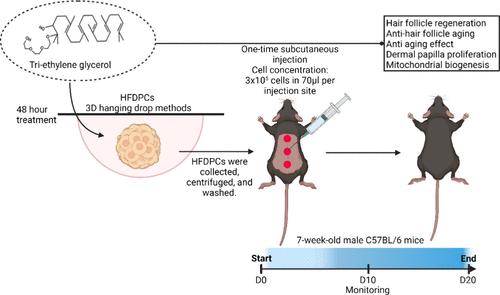当前位置:
X-MOL 学术
›
ACS Pharmacol. Transl. Sci.
›
论文详情
Our official English website, www.x-mol.net, welcomes your feedback! (Note: you will need to create a separate account there.)
Triethylene Glycol Squalene Improves Hair Regeneration by Maintaining the Inductive Capacity of Human Dermal Papilla Cells and Preventing Premature Aging
ACS Pharmacology & Translational Science ( IF 4.9 ) Pub Date : 2024-06-12 , DOI: 10.1021/acsptsci.4c00114 Meriem Bejaoui 1, 2, 3 , Aprill Kee Oliva Mizushima 2, 3 , Tran Ngoc Linh 1 , Takashi Arimura 1 , Kenichi Tominaga 1 , Hiroko Isoda 1, 2, 3, 4
ACS Pharmacology & Translational Science ( IF 4.9 ) Pub Date : 2024-06-12 , DOI: 10.1021/acsptsci.4c00114 Meriem Bejaoui 1, 2, 3 , Aprill Kee Oliva Mizushima 2, 3 , Tran Ngoc Linh 1 , Takashi Arimura 1 , Kenichi Tominaga 1 , Hiroko Isoda 1, 2, 3, 4
Affiliation

|
De novo hair follicle (HF) regeneration, achieved through the replenishment of the dermal papilla (DP), acknowledged as the principal orchestrator of the hair growth cycle, is emerging as a prospective therapeutic intervention for alopecia. Nonetheless, multiple attempts have shown that these cells lose key inductive properties when cultured in a two-dimensional (2D) monolayer, leading to precocious senescence engendered by oxidative stress and inflammatory processes. Consequently, the three-dimensional (3D) spheroid technique is presently widely employed for DP cell culture. Nevertheless, substantiating the regenerative potential of these cells within the hair follicle (HF) milieu remains a challenge. In this current study, we aim to find a new approach to activate the inductive properties of DP cells. This involves the application of hair-growth-stimulating agents that not only exhibit concurrent protective efficacy against the aging process but also induce HF regeneration. To achieve this objective, we initially synthesized a novel highly amphiphilic derivative derived from squalene (SQ), named triethylene glycol squalene (Tri-SQ). Squalene itself is a potent antioxidant and anti-inflammatory compound traditionally employed as a drug carrier for alopecia treatment. However, its application is limited due to its low solubility. Subsequently, we applied this newly synthesized derivative to DP cells. The data obtained demonstrated that the derivative exhibits robust antioxidant and anti-inflammatory activities while concurrently promoting the expression of genes associated with hair growth. Moreover, to further assess the hair regrowth inductive properties of DP cells, we cultured the cells and treated them with Tri-SQ within a 3D spheroid system. Subsequently, these treated cells were injected into the previously depilated dorsal area of six-week-old male C57BL/6 mice. Results revealed that 20 days postinjection, a complete regrowth of hair in the previously hairless area, particularly evident in the case of 3D spheroids treated with the derivative, was observed. Additionally, histological and molecular analyses demonstrated an upregulation of markers associated with hair growth and a concurrent decrease in aging hallmarks, specifically in the 3D spheroids treated with the compound. In summary, our approach, which involves the treatment of Tri-SQ combined with a 3D spheroid system, exhibited a notably robust stimulating effect. This effect was observed in the induction of inductive properties in DP cells, leading to HF regeneration, and concurrently, it demonstrated an inhibitory effect on cellular and follicular aging.
中文翻译:

三甘醇角鲨烯通过维持人体真皮乳头细胞的诱导能力并防止过早衰老来改善头发再生
毛囊(HF)从头再生是通过真皮乳头(DP)的补充来实现的,被认为是头发生长周期的主要协调者,正在成为脱发的一种前瞻性治疗干预措施。尽管如此,多次尝试表明,这些细胞在二维(2D)单层培养时会失去关键的诱导特性,导致氧化应激和炎症过程引起的早衰。因此,三维 (3D) 球体技术目前广泛应用于 DP 细胞培养。然而,证实毛囊(HF)环境中这些细胞的再生潜力仍然是一个挑战。在当前的研究中,我们的目标是找到一种新方法来激活 DP 细胞的诱导特性。这涉及到毛发生长刺激剂的应用,该剂不仅具有对抗衰老过程的同时保护功效,而且还能诱导 HF 再生。为了实现这一目标,我们首先合成了一种源自角鲨烯(SQ)的新型高度两亲性衍生物,命名为三甘醇角鲨烯(Tri-SQ)。角鲨烯本身是一种有效的抗氧化剂和抗炎化合物,传统上用作治疗脱发的药物载体。但由于其溶解度低,其应用受到限制。随后,我们将这种新合成的衍生物应用于 DP 细胞。获得的数据表明,该衍生物具有强大的抗氧化和抗炎活性,同时促进与毛发生长相关的基因的表达。此外,为了进一步评估 DP 细胞的毛发再生诱导特性,我们培养了细胞并在 3D 球体系统中用 Tri-SQ 处理它们。 随后,将这些处理过的细胞注射到六周龄雄性 C57BL/6 小鼠先前脱毛的背部区域。结果显示,注射 20 天后,观察到先前无毛区域的毛发完全再生,在用衍生物处理的 3D 球体中尤其明显。此外,组织学和分子分析表明,与毛发生长相关的标记物上调,同时衰老特征减少,特别是在用该化合物处理的 3D 球体中。总之,我们的方法涉及 Tri-SQ 与 3D 球体系统相结合的治疗,表现出明显强大的刺激效果。这种效应在 DP 细胞诱导特性的诱导中观察到,导致 HF 再生,同时,它表现出对细胞和毛囊衰老的抑制作用。
更新日期:2024-06-12
中文翻译:

三甘醇角鲨烯通过维持人体真皮乳头细胞的诱导能力并防止过早衰老来改善头发再生
毛囊(HF)从头再生是通过真皮乳头(DP)的补充来实现的,被认为是头发生长周期的主要协调者,正在成为脱发的一种前瞻性治疗干预措施。尽管如此,多次尝试表明,这些细胞在二维(2D)单层培养时会失去关键的诱导特性,导致氧化应激和炎症过程引起的早衰。因此,三维 (3D) 球体技术目前广泛应用于 DP 细胞培养。然而,证实毛囊(HF)环境中这些细胞的再生潜力仍然是一个挑战。在当前的研究中,我们的目标是找到一种新方法来激活 DP 细胞的诱导特性。这涉及到毛发生长刺激剂的应用,该剂不仅具有对抗衰老过程的同时保护功效,而且还能诱导 HF 再生。为了实现这一目标,我们首先合成了一种源自角鲨烯(SQ)的新型高度两亲性衍生物,命名为三甘醇角鲨烯(Tri-SQ)。角鲨烯本身是一种有效的抗氧化剂和抗炎化合物,传统上用作治疗脱发的药物载体。但由于其溶解度低,其应用受到限制。随后,我们将这种新合成的衍生物应用于 DP 细胞。获得的数据表明,该衍生物具有强大的抗氧化和抗炎活性,同时促进与毛发生长相关的基因的表达。此外,为了进一步评估 DP 细胞的毛发再生诱导特性,我们培养了细胞并在 3D 球体系统中用 Tri-SQ 处理它们。 随后,将这些处理过的细胞注射到六周龄雄性 C57BL/6 小鼠先前脱毛的背部区域。结果显示,注射 20 天后,观察到先前无毛区域的毛发完全再生,在用衍生物处理的 3D 球体中尤其明显。此外,组织学和分子分析表明,与毛发生长相关的标记物上调,同时衰老特征减少,特别是在用该化合物处理的 3D 球体中。总之,我们的方法涉及 Tri-SQ 与 3D 球体系统相结合的治疗,表现出明显强大的刺激效果。这种效应在 DP 细胞诱导特性的诱导中观察到,导致 HF 再生,同时,它表现出对细胞和毛囊衰老的抑制作用。










































 京公网安备 11010802027423号
京公网安备 11010802027423号